Mastering Raised Garden Beds for Optimal Tomato Growth
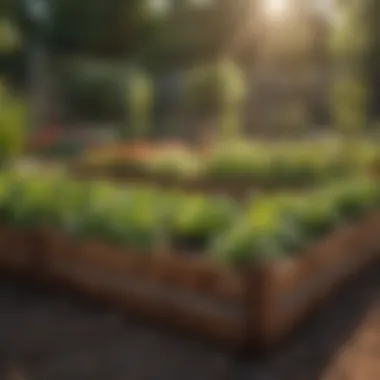

Intro
Raised garden beds have gained popularity among gardeners, especially for growing tomatoes. There are several reasons for this trend, ranging from improved drainage to better control over soil quality. This article delves into the best practices for optimizing these beds for tomato plants. The reader will gain insight into the design aspects, maintenance routines, and pest management strategies that can elevate tomato cultivation.
The overall goal is to transform a simple gardening experience into a fruitful venture, whether one is just beginning or has years of experience. With tomatoes being a staple crop, the insights shared here aim to enhance both yield and quality, thus making the gardening journey more rewarding. Let's explore the design inspiration first, which sets the foundation for successful gardening.
Benefits of Raised Garden Beds
Raised garden beds offer several advantages that can significantly enhance the experience for gardeners, particularly those focused on cultivating tomato plants. The elevation provided by raised beds not only influences plant health but also affects the overall management of the garden. This section explores how raised garden beds can optimize space, improve conditions for growth, and create a more efficient gardening experience.
Improved Soil Drainage
Raised garden beds typically have superior drainage compared to traditional garden plots. The soil in a raised bed is often looser and composed of a better mix of organic material, allowing excess water to drain away more efficiently. Proper drainage is essential for tomato plants, as over-saturation can lead to root rot and various diseases.
Creating a raised bed also permits a more tailored soil structure. You can mix different soils and additives such as compost to enhance drainage capabilities. This setup means tomatoes can thrive in an environment tailored to their specific growing conditions. Consequently, gardeners should consider the elevation of beds to ensure effective drainage.
Enhanced Accessibility
Accessibility is another major benefit of raised garden beds. These structures allow for easier maintenance, potentially catering to gardeners of all ages and physical abilities. By elevating the soil, individuals do not need to bend down as much, which can reduce strain on the back and knees. For individuals with limited mobility, raised beds can be designed with height in mind, allowing them to enjoy gardening without challenges.
In addition, accessibility extends to the management of watering and fertilization systems. With well-placed raised beds, gardeners can have better control over these elements, further supporting healthy tomato growth. This ease of access encourages consistent care and timely interventions when needed.
Better Pest Control
Raised beds can also contribute to better pest management. The elevation can deter some common pests that prefer ground level to hide or lay eggs. Moreover, raised beds can be designed with physical barriers such as mesh or fabric to protect against birds and larger pests. This proactive approach helps in maintaining the health of tomato plants.
Additionally, by being vigilant in monitoring pest activity, gardeners can quickly implement integrated pest management strategies. Using raised beds facilitates an organized layout for companion planting, where certain plants are placed together to naturally repel pests or attract beneficial insects.
Extended Growing Season
One notable benefit of raised garden beds is the potential for an extended growing season. The soil in raised beds tends to warm up more quickly in the spring due to increased exposure to sunlight and air circulation. This can enable earlier planting of tomato seeds or transplants than in traditional gardens.
Furthermore, as the season changes, raised beds can also retain warmth longer into the fall. By using methods such as row covers or mulch, gardeners can further extend the growing period for their tomato plants. This may translate into a higher yield and the opportunity to harvest tomatoes later in the year.
In summary, the benefits of raised garden beds include better soil drainage, enhanced accessibility, improved pest control, and the possibility of a longer growing season.
Through these aspects, raised beds present a practical and effective solution for cultivating tomatoes, aligning with the needs of both novice and experienced gardeners.
Choosing the Right Location
The choice of location for raised garden beds is critical for the successful cultivation of tomato plants. Tomatoes thrive in specific environmental conditions, so understanding the key factors that influence growth will directly impact yield and quality. Factors such as sunlight, wind protection, and proximity to water sources are all vital in determining the optimal setting for raised beds.
Sunlight Requirements
Sunlight is perhaps the most significant factor when positioning raised garden beds for tomato plants. Ideally, tomatoes require a minimum of six to eight hours of direct sunlight each day. Insufficient sunlight can result in poor growth and fewer fruit yields. When selecting a location, observe the area throughout the day to identify where sunlight is most favorable. Keep in mind that some plants or structures around your garden can create shade; thus, it is essential to ensure that your tomato plants get adequate light exposure.
In addition to direct sunlight, consider the angle of the sun during different seasons. For example, in winter, the sun's path changes, and areas that might typically be sunny can become shaded. Choose a spot that remains sunlit throughout the year to maximize growth potential.
Wind Protection Strategies
Wind can have a detrimental effect on tomato plants, particularly during their flowering and fruiting stages. Strong winds can damage leaves, break branches, and even uproot newly planted seedlings. Therefore, incorporating wind protection strategies is essential when selecting a location for your raised beds.
One effective approach is to position the beds near natural barriers, such as fences or shrubs. These elements can serve as windbreaks. Also, consider the elevation of your garden area. Areas that are higher can experience stronger winds. If you live in such a region, think about using additional barriers, such as mesh or other materials, to provide extra protection for your tender plants.
Proximity to Water Sources
Access to water is a key consideration for any gardening endeavor. Raised garden beds for tomatoes demand consistent moisture to ensure healthy growth. Ideally, choose a site that is close to a reliable water source, making the irrigation process more manageable and efficient.
Look into different irrigation techniques, such as drip systems or soaker hoses, to maintain adequate moisture levels without overwatering. Both are water-efficient options that deliver moisture directly to the root zone.
Furthermore, developing a watering schedule that aligns with the specific moisture needs of tomatoes is vital. Be aware that tomatoes generally prefer well-drained soil, so ensure that the location facilitates proper drainage, whether you are using a simple garden hose or more complex irrigation solutions.
"Choosing the right location for your raised garden bed sets the foundation for a fruitful gardening experience. Proper sunlight, wind protection, and easy access to water are essential components of successful tomato cultivation."
Designing the Raised Bed
The design of raised garden beds is a crucial element in the optimization of tomato plants. This aspect involves various important factors, such as dimensions, materials, and orientation. Optimally designed raised beds not only enhance the health and productivity of tomato plants but also create an efficient gardening environment. Taking the time to carefully consider each design factor can lead to better results and a more enjoyable gardening experience.
Ideal Dimensions for Tomato Plants
When determining the dimensions for raised beds, it is important to consider the growth habits of tomato plants. A bed typically needs to be at least 3 to 4 feet wide. This allows sufficient space for tomato plants without sacrificing accessibility for maintenance tasks like pruning and harvesting. Height is another vital aspect; a elevation of 12 to 24 inches is often ideal, as this can promote root health while deterring some pests. The length can vary, but a typical range is from 4 to 8 feet. This balance of dimensions ensures that tomatoes have enough space to grow while facilitating easy care.
Material Selection
Selecting the right materials for raised garden beds is a critical decision, as materials directly affect durability, cost, and maintenance. There are several popular options to consider:
Wood
Wood is a traditional and favored choice for raised garden beds. Its natural appearance blends well into most landscapes. One specific aspect of wood is its biodegradability; choosing untreated cedar can provide a long-lasting solution. Cedar’s natural oils help it resist decay, which contributes to its appeal as a sustainable option. However, it is essential to be aware of the potential disadvantages. Untreated wood can eventually rot, generally within five to ten years depending on the environment. Choosing treated wood, while extending its lifespan, may introduce chemicals that can leach into the soil.
Composite Materials
Composite materials are an increasingly popular choice due to their durability and environmental advantages. Made from reclaimed wood fibers and plastics, composite materials resist rot and insects effectively. A notable characteristic is their low-maintenance quality; unlike wood, they do not require frequent painting or sealing. The unique feature of composite material is its resistance to warping, which can be beneficial. However, cost can be a disadvantage as composites tend to be more expensive compared to wood.
Metal
Metal raised beds bring a modern aesthetic to gardening. Galvanized steel is commonly used, as it is highly durable and resistant to rust. One key characteristic is its thermal properties; metal can heat up quickly in the sunlight, which may promote an earlier growing season. Its longevity is another advantage, as it lasts much longer than wood. However, one needs to consider that metal conducts heat, which can lead to overheating during extreme conditions, potentially harming roots. Also, the initial setup cost can be higher.
Bed Orientation
The orientation of the raised bed is fundamental to ensuring optimal sunlight exposure. Aligning the longer sides of the raised bed north to south will maximize sunlight access throughout the day. This arrangement helps tomatoes receive ample light necessary for their growth. Additionally, it is essential to think about spacing between beds; sufficient space allows for air circulation, reducing the chance of disease. Observing shade patterns from surrounding structures or trees can also inform the best placement.
Proper design of raised garden beds not only optimizes growing conditions but also future-proofs your gardening efforts against pest issues and weather conditions.
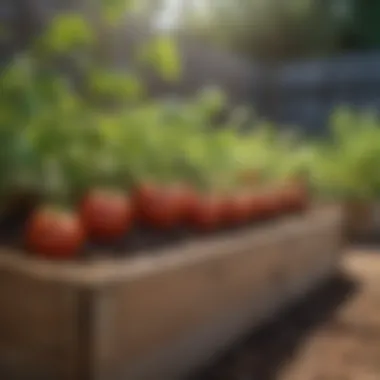
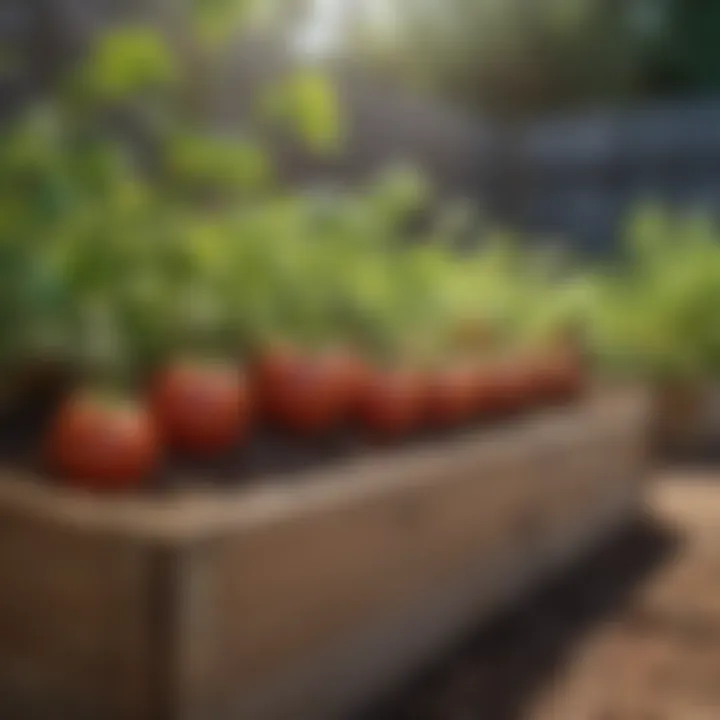
Optimal Soil Composition
The right soil composition is critical for the health and yield of tomato plants grown in raised garden beds. It directly influences root development, nutrient uptake, and overall plant vigor. A well-structured soil holds moisture yet drains excess water effectively. It also supports a diverse microbiome that helps break down organic matter, supplying plants with the necessary nutrients.
For gardeners, achieving optimal soil composition means focusing on the essential components: texture, structure, and fertility. Each aspect contributes to creating a hospitable environment for tomato plants.
Organic Matter Integration
Integrating organic matter into the soil provides multiple benefits. Organic materials, such as compost, decomposed leaves, and well-rotted manure, enhance soil fertility. They can improve soil texture and structure, promoting better aeration and moisture retention.
When applying organic matter, it is crucial to consider the right ratio. A general guideline is to incorporate approximately 30% organic material by volume in the raised bed. This addition aids in the formation of healthy soil aggregates, which creates a balance of air and water spaces conducive to root growth. A healthy amount of organic matter decomposes over time, releasing nutrients essential for robust tomato growth.
It also favours beneficial microbial life, which helps to break down compounds into forms that the plants can readily absorb.
Nutrient Requirements
Tomatoes thrive in a nutrient-rich environment. Several key nutrients are essential for optimal growth: nitrogen, phosphorus, and potassium. Each nutrient plays a specific role in the plant's development:
- Nitrogen supports leaf and stem growth, fostering lush vegetation.
- Phosphorus is critical for root development and flower production.
- Potassium enhances fruit quality and plant resistance to disease.
To ensure that your raised bed soil meets these nutrient requirements, it is advisable to conduct a soil test. A soil test can reveal the existing nutrient levels and pH balance, guiding your fertilization strategy. Based on the results, you may choose to apply a balanced fertilizer, or specific nutrient amendments to tailor the soil composition to the plant's needs. Organic fertilizers, such as fish emulsion or blood meal, are often recommended due to their slow-release properties and beneficial impacts on soil health.
Watering Practices
Proper watering practices are crucial for the health and productivity of tomato plants in raised garden beds. This aspect not only affects growth rates but also influences the quality of the yield. Tomatoes demand consistent moisture, and too much or too little can lead to stress, affecting flowering and fruit development. Therefore, understanding different irrigation techniques and establishing a watering schedule are paramount for optimizing plant health.
Irrigation Techniques
Choosing the right irrigation technique is essential. Here are some common approaches:
- Drip Irrigation: This method delivers water directly to the roots using a system of tubing and emitters. It minimizes evaporation and runoff, ensuring that tomatoes receive adequate moisture. This technique conserves water and reduces the risk of fungal diseases since it keeps the foliage dry.
- Soaker Hoses: These hoses allow water to seep out slowly along their length. They are laid out within the beds, delivering moisture directly to the soil. This technique can be efficient, though regular garden monitoring is needed to adjust flow based on climate conditions.
- Hand Watering: Using a watering can or hose might seem straightforward, yet it requires discipline. Gardeners must be vigilant to avoid both overwatering and underwatering. This technique provides flexibility but can be labor-intensive.
"Watering technique can significantly influence the development of the plant. Chose wisely."
Each method has its benefits and considerations. Factors such as the size of the garden, budget, and personal preference will dictate the best choice. Regular assessment allows for adjustments to meet the plant's evolving needs.
Watering Schedule
Establishing a watering schedule is as important as selecting a technique. Tomatoes prefer deep watering, promoting strong root systems. A standard guideline is to aim for 1 to 1.5 inches of water per week. However, this can vary due to several factors:
- Climate: Hotter days require more frequent watering, as evaporation increases. Conversely, cooler temperatures may allow for less frequent hydration.
- Soil Type: Sandy soils drain quickly and may need more frequent watering, whereas clay soils retain moisture longer. Monitoring the soil can guide adjustments.
- Container Size and Plant Size: Larger containers and more mature plants will need greater water intake as they grow.
Employing a simple rule can help gardeners determine when to water: if the top inch of soil feels dry, it's time to water. Additionally, checking in the morning is best to prevent heat loss and ensure water penetrates deeply before the day's heat intensifies.
In summary, optimizing watering practices requires dedication and observation. Implementing efficient irrigation techniques and scheduling can notably influence the vitality and production of tomato plants. By understanding their specific needs, gardeners can cultivate a thriving environment for their crops.
Fertilization Strategies
Fertilization is a vital aspect of successfully cultivating tomato plants in raised garden beds. The right fertilization strategy not only enhances plant growth but also helps in achieving robust yields. Tomatoes require specific nutrients during their growth cycle, and understanding how to supply these nutrients can significantly impact the quality of the harvest.
Using adequately timed and formulated fertilizers can prevent deficiencies, avoid excesses, and promote healthy, vigorous growth. The focus should be on selecting the right fertilizer types and applying them at the correct times to maximize their effectiveness.
Types of Fertilizers
When it comes to fertilizing tomatoes, there are several types to consider:
- Organic Fertilizers
These are derived from natural sources. Examples include compost, manure, and bone meal. Organic fertilizers improve soil fertility and enhance the soil structure over time, supporting beneficial microbial activity. - Synthetic Fertilizers
These are chemical products designed to provide specific nutrients in defined concentrations. They often deliver nutrients quickly but can lead to nutrient leaching if not used properly. Common examples include those high in nitrogen, phosphorus, and potassium—essential for tomato health. - Slow-Release Fertilizers
These fertilizers release nutrients gradually over time. This can be a great solution for maintaining consistent nutrient availability without frequent applications. They often contain a balanced mix of essential elements, allowing for steady plant growth. - Liquid Fertilizers
These are typically used for quick nutrient absorption. They can be applied directly to the foliage or soil. It's important to follow the recommended dilution rates to avoid over-fertilization.
Understanding the nutritional needs of tomato plants and the existing soil conditions will aid in selecting the appropriate fertilizer type suitable for your growing conditions.
Application Timing
The timing of fertilizer application is critical for maximizing the benefits. Here are some key points to consider:
- Pre-Planting:
Before planting tomatoes, incorporating compost or well-rotted manure into the soil can establish a nutrient-rich base. Doing this a few weeks before planting allows the nutrients to integrate into the soil. - Early Growth Stage:
During the early growth phase, typically when plants are about 6 to 8 inches tall, applying a balanced fertilizer can support healthy development. This helps in establishing strong roots and foliage. - Flowering Stage:
As tomato plants enter the flowering stage, a fertilizer higher in potassium is beneficial. This nutrient supports flower development and fruit set, increasing the chances of a fruitful harvest. - During Fruit Development:
Continue to monitor the plants, as additional fertilization may be necessary. A boost with a liquid fertilizer during this period can enhance fruit size and yield. Timing this correctly can mean the difference between a good and a great harvest.
It is important to avoid over-fertilizing, as this can lead to excessive foliage growth while inhibiting fruit development.
Pruning Techniques for Tomato Plants
Pruning is an essential practice in the cultivation of tomato plants, especially in raised garden beds. It helps manage plant growth and promotes better fruit production. When performed correctly, pruning can lead to healthier plants and a more bountiful harvest. It allows for better air circulation, light penetration, and reduces the risk of diseases. Moreover, pruning encourages the plant to focus its energy on producing more fruit rather than excessive foliage.
When to Prune
Timing is critical when it comes to pruning tomato plants. Ideally, it should begin when the plants reach about 12 to 18 inches in height. At this stage, you can easily identify suckers, which are the small shoots that grow between the main stem and the branches. These suckers can sap the energy from the plant and inhibit fruit production compared to the flowers.
In general, here are some key periods for pruning:
- Early Growth: Start removing suckers early on, usually within the first month of planting.
- Mid-Growth: Continue to prune as the plant grows, particularly once it starts flowering.
- Before Harvest: A final clean-up can be beneficial a few weeks before harvest to ensure the plant's energy is focused on mature fruit.
Pruning Methods
There are several methods to prune tomato plants. The most common techniques include:
- Sucker Removal: This method involves pinching off the suckers as they appear. Aim to remove suckers when they are young and small, as it reduces stress on the plant.
- Top Pruning: Once your plant has grown to the desired height, you can top the plant to encourage lateral growth. Cut the main stem just above the top flowers.
- Leaf Pruning: As the tomato plant matures, older leaves may become yellow or diseased. Trim these leaves to enhance air circulation and reduce the chance of diseases taking hold.
Proper pruning is critical for maximizing tomato yields in raised beds. It can help the plants develop well and produce more fruitful harvests.
Remember, pruning should be done with care to avoid stressing the plant too much. A few well-timed cuts will benefit the entire garden. Always keep your pruning shears clean to prevent disease transmission between plants.
Pest Management Approaches
Effective pest management is an essential component of gardening, particularly when growing tomatoes in raised beds. These plants, while resilient, can still fall victim to various pests that threaten both their health and yield. Understanding pest management approaches helps gardeners identify potential threats early and implement control measures that protect their tomato plants without harming the organic structure of their garden.


Common Tomato Pests
Tomato plants may encounter several common pests throughout their growing season. Some of the pests that gardeners should watch for include:
- Aphids: These small, soft-bodied insects suck sap from plants and can cause leaves to curl and yellow.
- Whiteflies: These winged pests also feed on plant sap and can transmit viruses.
- Spider Mites: Although not insects, these tiny arachnids can create fine webs and cause stippling on leaves.
- Tomato Hornworms: Large caterpillars that can quickly defoliate plants, leading to severe crop loss.
- Cutworms: These larvae feed on seedlings at the soil level, often cutting them down entirely.
By recognizing these pests early, gardeners can apply appropriate control measures before severe damage occurs.
Organic Pest Control Methods
For those who prefer organic gardening methods, there are numerous strategies to manage pests effectively. Here are some successful organic pest control methods that can help ensure healthy tomato plants:
- Companion Planting: Some plants, like marigolds and basil, can deter pests. Planting these near tomatoes can create a pest-repelling barrier.
- Neem Oil: This natural insecticide is derived from the seeds of the neem tree. It disrupts the life cycle of many pests and is safe for beneficial insects when used properly.
- Insecticidal Soap: Made from natural ingredients, insecticidal soap can help control aphids and spider mites by suffocating them.
- Handpicking: Inspecting plants regularly to physically remove pests, such as hornworms, can be one of the most effective methods of control.
- Beneficial Insects: Introducing predatory insects like ladybugs and lacewings can help keep pest populations in check.
Using these organic control methods not only maintains garden health but also supports sustainable practices.
"Understanding pest management approaches is not just about applying chemicals but also about nurturing a balanced ecosystem."
Disease Prevention and Management
Disease prevention and management are critical components in the successful cultivation of tomato plants in raised garden beds. Tomatoes are prone to various diseases that can severely affect our yield and the overall health of the plants. Therefore, understanding how to identify common diseases and implementing preventative measures can help ensure a thriving garden.
Identifying Common Diseases
Tomato plants can face several diseases, each presenting different symptoms. Some common diseases to be aware of include:
- Blight: This fungal infection can be particularly damaging. It typically begins as dark spots on the leaves, which can eventually lead to wilting and death of the plant.
- Powdery Mildew: This white fungal growth appears on the leaves and stems. It can impede growth and reduce photosynthesis.
- Tomato Mosaic Virus: This virus causes the leaves to exhibit mottled patterns and can stunt plant growth. Once infected, plants cannot be cured.
- Root Rot: Often caused by poor drainage, root rot affects the plants' roots. Symptoms include yellowing leaves and stunted growth.
Identifying these diseases early is imperative to prevent widespread damage.
Preventative Measures
Taking proactive steps can significantly reduce the risk of disease in tomato plants. Consider the following measures:
- Select Disease-Resistant Varieties: Choose tomato varieties known for their resistance to specific diseases. Doing this can provide a robust first line of defense.
- Proper Spacing: Ensure adequate spacing between plants to promote airflow. This practice helps keep foliage dry and discourages fungal growth.
- Regular Observation: Check plants frequently for signs of disease. Early detection allows for quicker response.
- Healthy Soil: Maintain high soil quality by incorporating organic matter. Healthy soil supports strong plants with better resilience against diseases.
- Crop Rotation: Avoid planting tomatoes in the same bed year after year. This practice helps mitigate the build-up of soil-borne pathogens.
- Watering Practices: Water at the soil level, avoiding the leaves. Overhead watering can promote leaf diseases. Ensure the soil is well-drained to prevent root rot.
"Preventative measures are more effective than treatment options when it comes to maintaining the health of tomato plants."
By understanding common diseases and implementing these preventative measures, gardeners can enhance their tomato crop's health and productivity.
Harvesting Techniques
Harvesting tomatoes at the right moment is crucial. The timing affects taste, durability, and nutrition. Ensuring optimal harvest timing maximizes yield and satisfaction. A well-planned harvest contributes to the overall success of gardening efforts. This section focuses on why harvesting techniques matter, along with specific details and implications.
Optimal Harvest Timing
Knowing when to harvest tomatoes is very important. Tomatoes do not ripen well after picking if they are too green. If harvested too late, they may become overripe and lose quality. The ideal timing is when tomatoes show full color without any green spots.
Another sign of readiness is the feel; ripe tomatoes should have a slight give when you gently squeeze them. Make sure to check for a firm, smooth surface. Weather conditions can influence timing too. Heatwaves or cold snaps may affect ripening.
Look for these indicators:
- Color: Deep red or the expected final color for the variety.
- Firmness: Slightly soft but not mushy.
- Stem Condition: The stem begins to turn brown or shrivel.
Proper Harvesting Methods
Proper techniques can influence the quality of the harvest. Careful handling can prevent bruising and damage. To harvest, grasp the tomato gently yet firmly and twist it slightly. This method is less likely to harm the plant. Avoid pulling directly, as this can lead to injury on the vine or breaking stems.
Here are key steps to consider:
- Use clean, sharp scissors or pruning shears for cutting.
- Harvest early in the day when temperatures are cooler.
- Place harvested tomatoes in a soft container to prevent bruising.
- Store picked tomatoes in a well-ventilated area, avoiding direct sunlight.
"Timely and skilled harvesting not only improves flavor but also extends shelf life, making your efforts worthwhile."
Post-Harvest Care
Post-Harvest Care is crucial in maximizing the fruits of your labor after harvesting tomatoes. Proper post-harvest processes not only enhance the shelf life of your tomatoes but also retain their flavor and nutritional value. As tomatoes have high water content, they can spoil quickly if not handled correctly. Hence, understanding the best practices for care after the harvest can mean the difference between fresh produce and wasted resources.
Storage Practices
Storing tomatoes correctly is fundamental to preserving their freshness. Here are key points to consider:
- Temperature Control: Tomatoes should ideally be stored at room temperature. Refrigeration can alter their flavor and texture. If tomatoes are particularly ripe, they can be stored in a cool, dark place such as a pantry.
- Moisture Management: Excess moisture can lead to rot. Ensure your tomatoes are dry before stacking them. Ideally, place them in a single layer to avoid bruising. If you store them in a container, use breathable materials, like cardboard.
- Ethylene Gas Awareness: Tomatoes produce ethylene, a gas that promotes ripening. Keep tomatoes away from other produce sensitive to this gas, such as bananas or apples, to prevent premature spoilage.
Considering these points can greatly impact how long your tomatoes remain in good condition after harvest.
Utilizing Surplus Tomatoes
After a bountiful harvest, you may find yourself with more tomatoes than you can consume immediately. Here are effective ways to utilize surplus tomatoes:
- Canning: Preserving tomatoes through canning allows you to enjoy them well beyond the growing season. Process them using a water bath or pressure canning methods, following safety guidelines to prevent spoilage.
- Freezing: Another excellent way to use excess tomatoes is to freeze them. Raw tomatoes can be blanched and then frozen, maintaining their flavor. Alternatively, you can prepare sauces and freeze them in smaller portions for later use.
- Dehydrating: Dried tomatoes add flavor to various dishes. Use a food dehydrator or an oven to remove moisture from the tomatoes.
- Sharing and Gifting: If you still have an abundance, consider sharing with neighbors, family, or friends. Community sharing can enhance relationships and minimize waste.
Crop Rotation Considerations
When it comes to cultivating tomato plants in raised garden beds, crop rotation plays a critical role. This practice involves alternating the types of crops grown in the same area over time. The benefits are manifold and impact both soil health and plant productivity.
Why Crop Rotation is Essential
Crop rotation is essential for several reasons. Firstly, it effectively manages soil fertility. Different plants have varying nutrient requirements. By rotating crops, gardeners can prevent nutrient depletion. For instance, tomatoes are heavy feeders, requiring substantial nitrogen. Following them with legumes, which enrich the soil with nitrogen, can restore nutrient balance.
Another significant factor is disease prevention. Certain diseases and pests are closely associated with specific plants. By rotating crops, you disrupt their life cycles, reducing the likelihood of infestations. This is particularly important for tomatoes which are susceptible to blights.
Furthermore, crop rotation contributes to a more diverse ecosystem in the garden. Each plant type attracts different beneficial insects and microorganisms, promoting overall health within the soil.
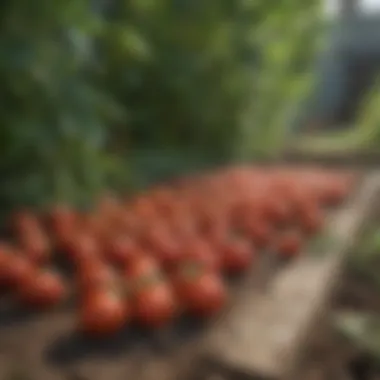
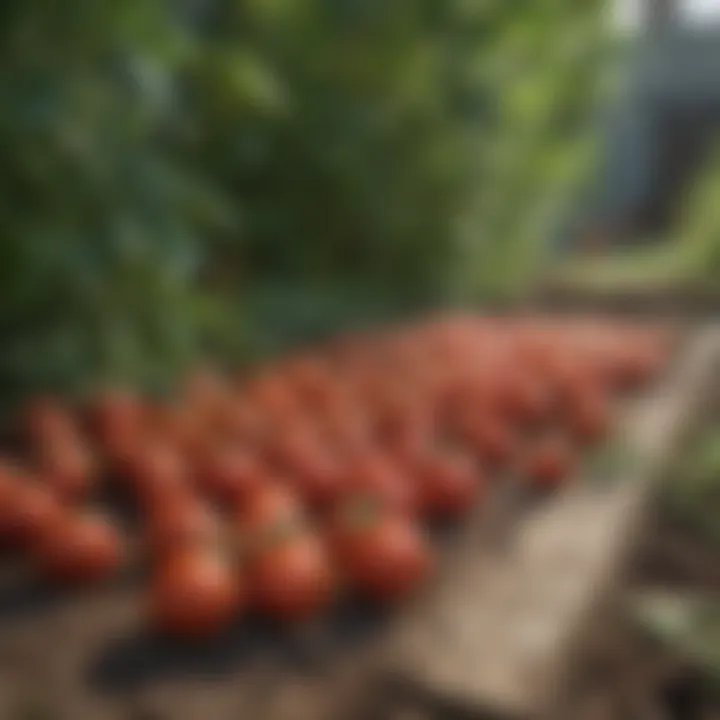
Implementing Effective Rotation Plans
To implement effective crop rotation, several steps should be considered. Start by planning a rotation schedule that covers multiple years. Ideally, follow tomatoes with crops that belong to different families. For instance, after tomatoes, consider planting beans or carrots. This breaks pest and disease cycles.
- Keep Records: Maintain a garden journal. Document what is planted each year and the observed outcomes. This helps refine future rotations based on prior successes or failures.
- Plan for Space: If your raised beds are limited, consider which beds can be alternated each season. Ensure that multiple areas are available to utilize this method effectively.
- Consider Companion Planting: Combine rotation with companion planting. For example, plant basil near tomatoes, which can help deter pests.
- Assess Soil Health Regularly: Monitor soil composition and structure throughout the seasons. Adjust your rotation plans based on any changes observed. Regular testing can inform your decisions on what to grow next.
By adhering to these principles of crop rotation, gardeners can optimize their raised beds for tomato plants. This approach not only enhances plant health but also builds a foundation for sustainable gardening practices.
Seasonal Adjustments
Adapting to the shifting seasons is critical for optimizing raised garden beds, especially when growing tomato plants. Each season presents unique challenges and opportunities for growth. Understanding the seasonal changes can directly influence the health and yield of crops.
Preparing for Winter
As temperatures drop, it is vital to prepare raised garden beds for winter. Tomatoes are sensitive to frost, and protecting them during the cold months is crucial. Here are some strategies to consider:
- Clear Debris: Remove any dead leaves and spent plants from the garden bed. This helps prevent pests from overwintering.
- Mulching: Adding a thick layer of mulch can insulate the soil, keeping it warmer and healthier during freezing temperatures.
- Covering Beds: Using frost cloths or row covers can protect the soil from snow and frost. This reduces the risk of soil erosion and maintains its structure.
"Effective winter preparation not only safeguards your plants but also lays the groundwork for a fruitful spring."
By implementing these practices, you create a protective environment that supports soil health.
Spring Planting Tips
Spring is the time for new beginnings in the garden. Here are some recommendations for optimizing raised beds for tomato planting:
- Testing Soil: Before planting, check the soil pH and nutrient levels. Tomatoes thrive at a pH between 6.0 and 6.8. Adjust as necessary with amendments such as lime or sulfur.
- Choosing Varieties: Select tomato varieties that suit your climate and personal preference. Indeterminate types generally produce longer but require staking for support.
- Seedling Care: Start seedlings indoors if possible. This gives them a head start and ensures they are strong when transplanted outdoor.
- Acclimation: Gradually introduce seedlings to outdoor conditions. This process, known as hardening off, reduces transplant shock.
By paying attention to these spring planting essentials, gardeners can significantly enhance their tomato yield. Adjustments made during these crucial seasons will contribute to a successful gardening experience.
Sustainable Practices in Gardening
Composting Benefits
Composting is an excellent way to recycle organic waste from your kitchen and garden. By composting, gardeners can produce nutrient-rich soil amendments that improve soil structure and fertility. Here are some key benefits of composting:
- Nutrient-Rich Additions: Compost provides essential nutrients to plants, including nitrogen, phosphorus, and potassium. These elements are critical for the growth and development of tomato plants.
- Soil Structure Improvement: Adding compost enhances soil structure by improving aeration and moisture retention. Well-aerated soil allows roots to grow more effectively, leading to healthier plants.
- Microbial Activity: Compost encourages beneficial microbial activity in the soil. These microorganisms aid in breaking down organic matter and make nutrients more accessible to plants.
Incorporating compost into your raised bed before planting tomatoes can dramatically enhance soil fertility and promote robust growth.
Natural Pest Deterrents
Utilizing natural pest deterrents aligns with sustainable gardening and minimizes reliance on chemical pesticides. Naturally deterring pests can enhance biodiversity while protecting tomato plants from harmful insects. Some effective natural pest control methods include:
- Companion Planting: Certain plants can deter pests when grown alongside tomatoes. For example, marigolds are known to repel nematodes and aphids, reducing pest populations.
- Essential Oils: Spraying diluted essential oils such as neem oil can provide a natural barrier against certain pests and diseases. Neem oil works by disrupting the life cycle of insects, preventing them from reproducing.
- Homemade Sprays: Simple sprays made from garlic or chili powder can ward off unwanted pests when applied directly to affected plants.
By adopting these natural pest management strategies, gardeners not only protect their tomato plants but also contribute to a healthier ecosystem.
Gardeners who integrate sustainable practices are likely to observe improved plant health and productivity. The symbiotic relationship between plants, soil, and microorganisms helps foster an enduring garden system.
Community Engagement in Gardening
Community engagement in gardening represents a vital aspect that enriches the experience of cultivating plants, especially tomatoes in raised garden beds. One of the primary benefits of engaging with the community is the sharing of knowledge and practical experiences. Gardeners often face challenges unique to their locale, and collaborating with local gardeners can provide insights that transcend traditional gardening methods. This exchange of ideas can lead to better practices, resulting in healthier plants and improved yields.
Moreover, community engagement fosters a sense of togetherness. By participating in community gardening events or workshops, individuals create social bonds that are deeply fulfilling. These connections often yield not just friendships, but also collaborative efforts in gardening projects that enhance both the local ecosystem and individual gardening success.
Another critical consideration is sustainability. Community initiatives can emphasize sustainable practices, encouraging members to adopt composting, water conservation, and organic pest management strategies. Such practices not only improve individual gardens but also contribute positively to the environment.
"Community gardening can transform urban landscapes, enrich lives, and promote environmental stewardship."
Sharing Resources
In the context of community engagement, sharing resources can take various forms. It can encompass seeds, tools, knowledge, or even experiences. For instance, seasoned gardeners might pass on tips about soil preparation or pest control to novices. When community members share seeds, they promote biodiversity, helping to maintain unique plant varieties that might otherwise be lost.
Establishing a resource-sharing platform can facilitate these exchanges. Community bulletin boards, online forums, or local social media groups can provide spaces for gardeners to connect. Additionally, creating workshops focused on skills, such as canning or preserving tomatoes, can maximize the knowledge shared among group members. This way, individuals not only learn about gardening but also about related culinary practices, thus deepening their connection to the food they grow.
Collaborative Gardening Projects
Collaborative gardening projects are crucial for amplifying the impact of communal gardening. These projects can range from small neighborhood gardens to larger community farms. They often unite diverse groups of people, pooling resources and knowledge to achieve a common goal: growing healthy food.
Engagement in these projects fosters team-building and cooperation. Working alongside others can ease the labor burden while enhancing learning outcomes. For example, individuals inexperienced in tomato cultivation can improve their techniques through observation and practice with more knowledgeable gardeners.
Successful collaborative efforts often include the following key aspects:
- Regular Meetings: Establishing a schedule for check-ins ensures everyone stays involved and informed.
- Leadership Roles: Designating leaders or coordinators can streamline decision-making, allowing projects to run smoothly.
- Shared Goals: Clearly defining objectives, such as plant health or production quantity, enables members to focus efforts effectively.
These collaborative gardening experiences can yield more than just crops; they nurture skills and relationships that help strengthen the community as a whole. Through engagement, individuals can transform ordinary gardening into something both productive and meaningful.
Closure
Understanding the benefits of raised garden beds offers gardeners advantages such as improved drainage and enhanced accessibility. These benefits not only promote healthier plants but also provide a more enjoyable gardening experience.
Moreover, proper soil composition cannot be understated. Integrating organic matter and ensuring adequate nutrients sets the foundation for strong tomato plants.
Regular watering is necessary, but it is equally important to adopt right techniques that match the specific need of tomato plants. The different fertilization strategies, including understanding when and what type of fertilizers to apply, contribute towards maximizing growth potential.
Consistently monitoring and managing common tomato pests and diseases remain imperative. Employing effective pest management while being aware of common diseases ensures that the crop is protected. Sustainable practices, including composting and utilizing natural pest deterrents, also add long-term benefits to garden health.
Finally, community engagement in gardening, through sharing resources and collaborating on projects, fosters a supportive environment that enhances learning and skills sharing among gardeners.
"The right strategies and knowledge can transform a simple garden into a thriving ecosystem of productivity."
By considering these key elements, any gardener can significantly enhance their efforts. The details put forth in this article form a coherent narrative, assisting both novices and seasoned gardeners in their quest for optimized tomato cultivation in raised beds.
Summarizing Key Takeaways
- Raised garden beds improve plant health by offering better drainage and easy access.
- Optimal soil composition is vital for strong growth and nutrient absorption.
- Regular and appropriate watering techniques are essential to avoid stress.
- Pest management strategies mitigate risks from common pests and diseases.
- Engaging with the gardening community enhances individual learning and development.
By applying these practices, the overall gardening experience improves, leading to greater satisfaction and yield in tomato farming.















